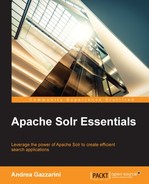Book Description
Leverage the power of Apache Solr to create efficient search applications
In Detail
Search is everywhere. Users always expect a search facility in mobile or web applications that allows them to find things in a fast and friendly manner.
Apache Solr Essentials is a fast-paced guide to help you quickly learn the process of creating a scalable, efficient, and powerful search application. The book starts off by explaining the fundamentals of Solr and then goes on to cover various topics such as data indexing, ways of extending Solr, client APIs and their indexing and data searching capabilities, an introduction to the administration, monitoring, and tuning of a Solr instance, as well as the concepts of sharding and replication. Next, you'll learn about various Solr extensions and how to contribute to the Solr community. By the end of this book, you will be able to create excellent search applications with the help of Solr.
What You Will Learn
- Index your data using formats such as XML, JSON, and CSV
- Manage, monitor, and tune a Solr instance
- Deploy Apache Solr in different environments, depending upon your project requirements
- Refine your search with various Solr client APIs
- Create custom components by leveraging the Apache Solr extension points
- Understand and utilize replication and sharding methods in a distributed search system
- Create and customize your own Solr instance for your project
Downloading the example code for this book. You can download the example code files for all Packt books you have purchased from your account at http://www.PacktPub.com. If you purchased this book elsewhere, you can visit http://www.PacktPub.com/support and register to have the files e-mailed directly to you.
Table of Contents
- Apache Solr Essentials
- Table of Contents
- Apache Solr Essentials
- Credits
- About the Author
- Acknowledgments
- About the Reviewers
- www.PacktPub.com
- Preface
- 1. Get Me Up and Running
- 2. Indexing Your Data
- 3. Searching Your Data
- 4. Client API
- 5. Administering and Tuning Solr
- 6. Deployment Scenarios
- 7. Solr Extensions
- 8. Contributing to Solr
- Index
